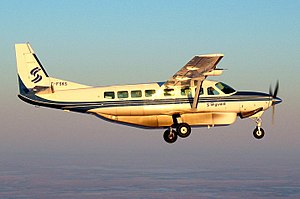Cessna Caravan
| Cessna 208 Caravan | |
|---|---|
 |
|
| 208B Grand caravan with cargo pod, inflight | |
| Role | Light transport turboprop |
| National origin | United States |
| Manufacturer | Cessna |
| First flight | August 8, 1982 |
| Introduction | 1984 |
| Status | In production |
| Primary users |
FedEx Feeder Brazilian Air Force Afghan National Army Air Force Colombian Air Force |
| Produced | 1982-present |
| Number built | 2,500 |
| Unit cost |
208 Caravan : US$1.95M (2016)
208B Grand C. EX : US$2.53M (2016) |
| Variants | Soloy Pathfinder 21 |
The Cessna 208 Caravan is an American single-engined turboprop, fixed-tricycle landing gear, short-haul regional airliner and utility aircraft that is built in the United States by Cessna. The airplane typically seats nine passengers with a single pilot, although with a FAR Part 23 waiver it can seat up to fourteen passengers. The aircraft is also used for cargo feederliner operations.
The Cessna 208 is a high-wing braced cabin monoplane powered by a single Pratt & Whitney Canada PT6A turboprop in tractor configuration. It has a fixed tricycle landing gear but can also be fitted with floats or skis. The cabin has room for nine passengers and two crew when used as a passenger aircraft with four doors, one for each crew member and an airstair door on right-side and a cargo door on the left. The aircraft can be optionally fitted with an underslung cargo pod.
The basic 208 airframe can be outfitted with various types of landing gear, allowing it to operate in a wide variety of environments. Some common adaptations include skis, enlarged tires for unprepared runways, and floats on the Caravan Amphibian model.
The Caravan interior can be outfitted with seats or as cargo holds. The standard high-density airline configuration has four rows of 1-2 seating behind the two seats in the cockpit. This variant is capable of holding up to thirteen passengers, although it is marketed as being able to make a profit carrying just four. The cabin can be configured in a low density passenger configuration, with 1-1 seating, as a combination of passengers and cargo, or as a strictly cargo aircraft. Many variants include an underbelly cargo pod, which can be used for additional freight capacity, or for passenger baggage. A number of Caravans are operated as skydiving aircraft with the left-side cargo hatch converted to a roll-up door.
...
Wikipedia
